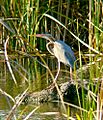Doñana National Park facts for kids
Quick facts for kids Doñana National Park |
|
|---|---|
|
IUCN Category II (National Park)
|
|

Marshes of Doñana in Huelva province
|
|
| Location | Huelva, Seville and Cádiz provinces - Andalusia, Spain |
| Area | 543 km2 (209.65 sq mi) |
| Established | 1969 |
| Visitors | 392,958 (in 2007) |
| Governing body | Andalusian Autonomous Government |
| Type: | Natural |
| Criteria: | vii, ix, x |
| Designated: | 1994 (18th session) |
| Reference #: | 685 |
| State Party: | Spain |
| Region: | Europe and North America |
| Extensions: | 2005 |
| Designated: | May 4, 1982 |
Doñana National Park is a very special nature area in southern Spain. It is located in Andalusia, a region in Spain. The park stretches across parts of the Huelva and Seville provinces.
This amazing park is found in a wetland area called Las Marismas. This is where the Guadalquivir River flows into the Atlantic Ocean. Doñana National Park covers about 543 square kilometers (210 square miles). A large part of this, 135 square kilometers (52 square miles), is specially protected.
You'll find different landscapes here, including marshes, shallow streams, and sandy dunes. The park was officially named a nature reserve in 1969. The World Wildlife Fund and the Spanish government worked together to buy and protect some of these important marshlands.
This amazing ecosystem has faced some threats over time. For example, people drained some marshes, used too much river water for farming, and built too many tourist places. The park gets its name from Doña Ana de Silva y Mendoza, who was the wife of a Spanish duke. In 2007, Doñana National Park was even chosen as one of the "12 Treasures of Spain."
Contents
Why Doñana Park is Important
Doñana National Park is one of Europe's most important wetlands. It is a vital place for many different animals and plants. Because of its unique nature, it has received several special titles.
World Heritage Site
In 1994, UNESCO named Doñana National Park a World Heritage Site. This means it is considered very important for everyone in the world to protect. It was recognized for its amazing natural beauty and its role in supporting many species.
Ramsar Site
The park is also a Ramsar site. This title is given to wetlands that are important for birds and other wildlife around the world. Doñana received this recognition on May 4, 1982. It shows how crucial its marshes are for migrating birds.
Biosphere Reserve
Doñana is also a Biosphere Reserve. This means it's a place where people try to balance nature conservation with human activities. It helps show how people and nature can live together.
Animals and Plants of Doñana
Doñana National Park is home to an incredible variety of wildlife. Many rare and endangered species live here.
Birds
The park is a paradise for birds, especially migratory birds. Millions of birds stop here on their long journeys between Africa and Europe. You can see many types of ducks, flamingoes, and herons. It is one of the best places in Europe for birdwatching.
Mammals
Doñana is famous for being home to the Iberian lynx. This is one of the most endangered cats in the world. The park plays a key role in trying to save this beautiful animal. Other mammals you might see include deer, wild boar, and badgers.
Reptiles and Amphibians
The park's wetlands and sandy areas are perfect for many reptiles and amphibians. You can find different types of snakes, lizards, and frogs here.
Plants
Doñana has a mix of habitats, from marshes to sand dunes and forests. This means many different types of plants grow here. You'll find pine trees, cork oaks, and special plants that can live in salty marsh water.
How the Park is Protected
Protecting Doñana National Park is a big job. The Andalusian Autonomous Government manages the park. They work to keep the different habitats healthy and protect the animals.
Challenges to Protection
Even with protection, the park faces challenges.
- Water Use: Too much water is sometimes taken from the rivers that feed the marshes. This is often for farming or tourism.
- Climate Change: Changes in weather patterns can affect the water levels in the marshes.
- Human Activity: Nearby towns and tourist areas can put pressure on the park's natural resources.
Scientists and park rangers work hard to find solutions to these problems. They try to make sure the park remains a safe home for its wildlife for many years to come.
Visiting Doñana National Park
Doñana National Park is open to visitors who want to learn about its nature. There are special visitor centers, like El Acebuche, where you can start your visit. You can take guided tours to see different parts of the park. This helps protect the sensitive areas while still allowing people to enjoy its beauty.
Images for kids
-
Iberian lynx, an emblematic species of the park
-
Rice field in Las Marismas, near Isla Mayor
See also
 In Spanish: Parque nacional y natural de Doñana para niños
In Spanish: Parque nacional y natural de Doñana para niños













